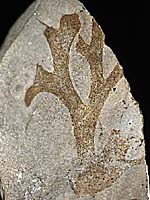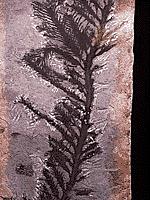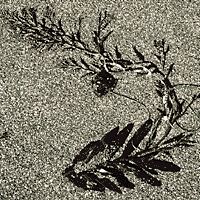







Possible fossil phaeophytes have been found in North American and Asian rocks as old as the Vendian, although some experts are sceptical about their identity. More likely fossil phaeophytes have been found in Ordovician and later rocks. One of these, Winnipegia, was described by W.L.Fry from shallow marine deposits near Lake Winnipeg, where thousands of these plants had apparently been deposited in place. Even these algae are placed among the Phaeophyta with some doubt.
The oldest fossils which defintely belong to the Phaeophyta are fossil kelps from the Tertiary. Miocene deposits have yielded taxa assignable to the extant orders Dictyotales, Laminariales, and Fucales. Julescraneia is a dichotomizing fossil blade attached to a floatation bladder, not unlike that in Nereocystis. Several species of another Miocene phaeophyte, Paleohalidrys, are known from California. Some produced a flattened nearly half-meter long thallus, and have been compared to members of the Cytoseiraceae, such as Cytoseira, pictured below at right. All these fossils come from the Monterey Formation of Southern California.
 |
 |
 |
Fossil Kelps : At left, Manitobia patula, a possible early kelp from the Ordovician of Canada; because only the outline is preserved, this may actually be a red alga. At center, Paleohalidrys superba, a fossil kelp from the Miocene age Monterey Formation of southern California. This genus has been compared to the modern kelps of the family Cytoseiraceae, such as Cytoseira, at right. What do you think?
The fossil record of phaeophytes is rather sparse, as these organisms do not produce hard parts, such as certain calcified red and green algae, nor do they produce resistant spores. Also, in the absence of pigments, fossil brown algae may be almost impossible to distinguish from these other algae, since there are many morphologically convergent forms among the three groups. These difficulties are compounded by the lack of trained paleobiologists who specialize on algae, or of phycologists who examine fossils.
The lack of recognizable brown algal fossils from the latter Paleozoic or from the Mesozoic has troubled many biologists who feel that the divergence must have occurred in the Precambrian. Others have proposed that the larger, recognizable forms, such as the kelps, may not have radiated until the Miocene, the time when animals associated with kelp-dominated communities first appear in the fossil record. In any case, the relatives of brown algae all first appear as fossils in the Jurassic or Cretaceous, suggesting that phaeophytes may have originated at that time as well.

Thomas N. and Edith L. Taylor, 1993. The Biology and Evolution of Fossil Plants. Prentice Hall, New Jersey.

